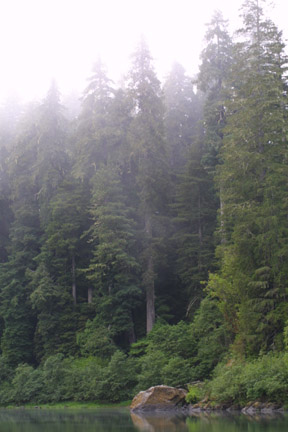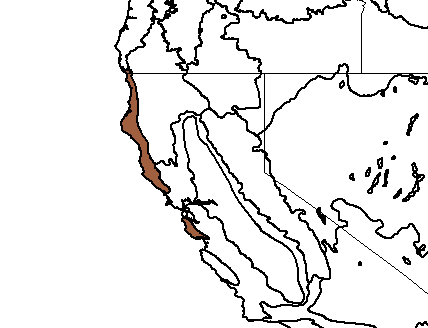
Sequoia sempervirens (redwood) along the Smith River, Jedediah Smith Redwoods State Park, California (c) 2005 Steven J. Baskauf
Bioimages home (click on an image to enlarge)
view
this page in its intended navigation context
Northern California Coastal Forests
(WWF
ecoregion
NA0519)

Sequoia sempervirens (redwood) along the
Smith River, Jedediah Smith Redwoods State Park, California
(c) 2005 Steven J.
Baskauf

Source of bioregions data:
Olson, D. M. and
E. Dinerstein. The Global 200: Priority ecoregions for global conservation. (PDF
file) Annals of the Missouri Botanical Garden 89:125-126.
Distinctiveness (1=highest,4=lowest): 1
(globally outstanding)
The distribution of Sequoia sempervirens (redwood) defines the extent of
this ecoregion. This is the tallest species of tree in the world
(individuals as tall as 369m) and it is the cornerstone of a globally unique
forest. The ecoregion also contains 8 endemic conifer species.*
Conservation Status (1=most endangered, 5=most
intact): 1 (critical)
Less than 4% of the original virgin redwood forests remain. The ecoregion
is threatened by logging, development, fire suppression, and invasive species.*
 Sequoia sempervirens (redwood)
(c) 2005 Steven J.
Baskauf hires
Sequoia sempervirens (redwood)
(c) 2005 Steven J.
Baskauf hires | Pseudotsuga menziesii | (Douglas fir) |
 | Lithocarpus densiflorus | (tanoak) |
 | Abies grandis | (grand fir) |
 | Tsuga heterophylla | (western hemlock) |
 | Picea sitchensis | (Sitka spruce) |
 | Thuja plicata | (western red cedar) |
 | Acer macrophyllum | (bigleaf maple) |
 | Arbutus menziesii | (Pacific madrone) |
 | Quercus garryana | (Oregon white oak) |
Associated habitats
old-growth redwood forest, Jedediah Smith Redwoods State Park, California




Far left: A lush understory grows beneath the world's tallest trees.
Middle left: Even in summer when there is reduced rainfall, fog from the ocean
rolls in, maintaining a high humidity level. Middle right: Tanoak (Lithocarpus densiflorus) is a common associate of redwood. Far right: The largest
redwoods have an enormous girth in addition to their great height. Along
with the high density of mature trees, this gives the old-growth redwood forest
one of the largest standing biomasses of any habitat.
(c) 2005 Steven J.
Baskauf hires
hires
hires, northern
CA (c)
2005 James H.
Bassett hires


The clear, cold, unpolluted water of the Smith River and its tributaries makes
it one of the few rivers in the western U.S. with a healthy spawning population
of salmon. The best spawning habitat is in shaded pools formed by fallen
trees and large branches in small streams that feed the river.
(c) 2005 Steven J.
Baskauf hires
hires
coastal cliffs, Redwoods National Park, California




Far left: Much of the coast is steep and rocky. Middle left: Fog from the ocean
plays an important role in the climate of this ecoregion. Middle right and far
right: Shrubs cover much of the steep slopes.
(c) 2005 Steven J.
Baskauf hires
hires
hires
hires


Left: Along some parts of the coast, Alnus rubra
(red alder) forms dense thickets which form a
solid canopy. Right: Below the canopy, a lush understory grows in the
shade.
(c) 2005 Steven J.
Baskauf
hires
hires
* Ricketts, T.H., E. Dinerstein, D.M. Olson, C.J. Loucks, et al. (1999) Terrestrial Ecoregions of North America: A Conservation Assessment. World Wildlife Fund - United States and Canada. Island Press, Washington, D.C. pp. 241-244.
Except as noted, images copyright 2002-2005 Steve Baskauf - Terms of use